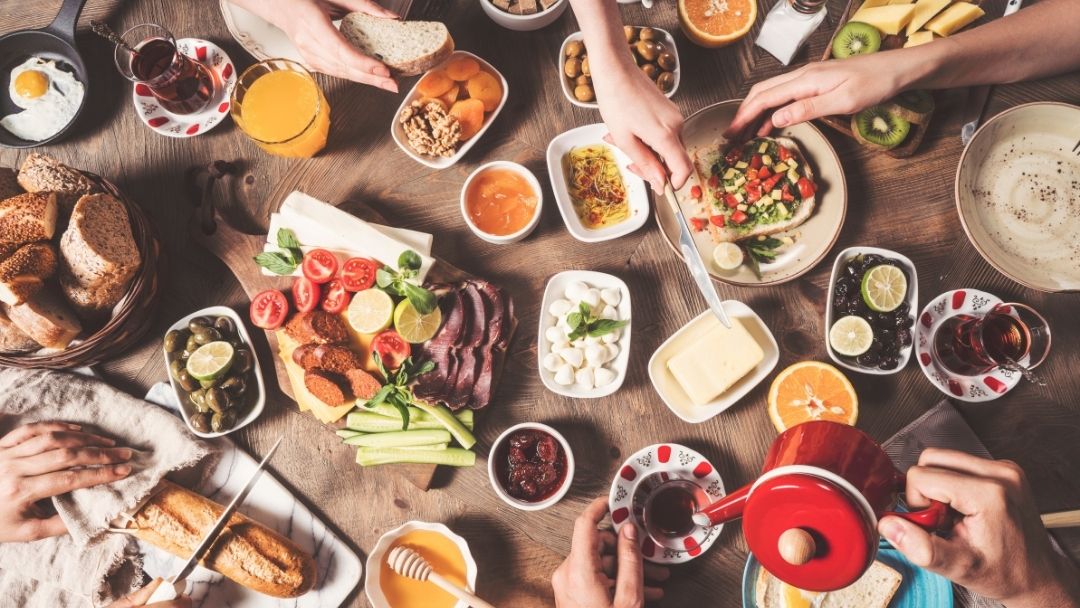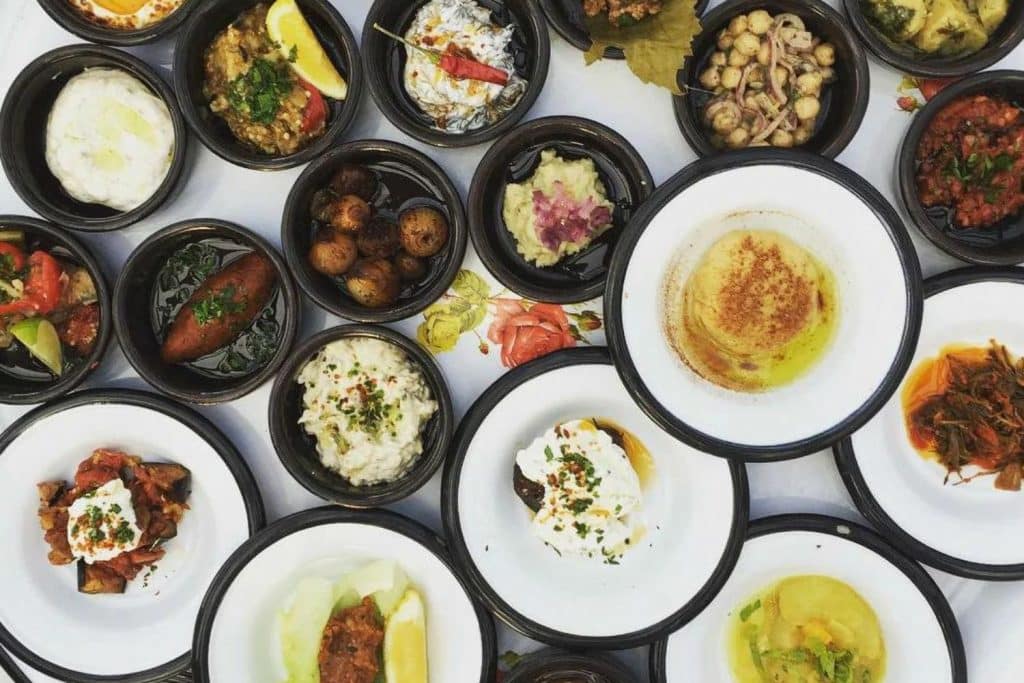Food in Turkey: Fall in love with these 8 Best Turkish Foods

The Art of Living in Turkey contains affiliate links and is a member of the Amazon Services LLC Associates Program. If you make a purchase using one of these Amazon links, I may receive compensation at no extra cost to you. See my Disclaimers for more information.
Are you planning a trip and curious about the traditional food in Turkey? You’re in the right place my friend!
Smells and tastes have an incredible way of bringing memories rushing back in an instant. Ever had a taste take you back to a familiar place somewhere in the past?
Like when your mom baked your grandma’s famous cinnamon rolls, and suddenly you’re a kid again, perched on the kitchen stool, listening to grandma’s stories about how she met granddad.
Smells and food are powerful in that way.
Turkey’s cuisine is no exception. It is rich, diverse, and absolutely memorable. The challenge? With so many options, it can be hard to know where to start!
Not all Turkish food is created equal, and as someone who’s been lucky enough to live here for many years now, I’ve definitely had a few dishes I’d pass on next time and I have eaten many I now eat regularly.
When you know where to go and what to order, you’ll uncover flavors that will make your tastebuds dance and will soon become staples in your diet.
I’ve written before about Turkish drinks (yes, including Turkish coffee!) and traditional desserts, but today, let’s dive into the best of Turkish food.
By the end of this post, you’ll have a list of must-try dishes that you’ll be craving before you even land. And trust me—it’s been a delicious journey tasting my way through Turkey just for you! Let’s get started on your culinary adventure.
What is Traditional Turkish Food?
Traditional Turkish food is characterized by a combination of historical, cultural, and geographical influences that have shaped its ingredients, cooking methods, and flavors over centuries.
Several factors contribute to the distinctiveness of traditional Turkish cuisine:
- Historical Heritage: Turkish cuisine has been influenced by a long history of various civilizations, including Ottoman, Byzantine, Persian, Arabic, and Balkan cultures.
This rich historical background has led to a fusion of culinary traditions, resulting in a diverse array of dishes. You can especially see this along the Eastern borders of Turkey. - Regional Diversity: Turkey spans multiple regions with different climates and landscapes, each contributing to a diverse range of ingredients and culinary practices.
The Black Sea, Mediterranean, Aegean, and Anatolian regions, for example, offer unique ingredients and flavors that are integral to their respective traditional dishes. - Use of Fresh Ingredients: Traditional Turkish dishes often emphasize the use of fresh and locally sourced ingredients.
Ingredients like vegetables, fruits, herbs, legumes, grains, and meats are often obtained from local markets and farms, contributing to the vibrant and authentic flavors.
This was seriously a game-changer for me. Vegetable dishes have so much more flavor here than in the States.
- Spices and Flavorings: Spices play a crucial role in traditional Turkish cuisine, adding depth and complexity to dishes.
Common spices include cumin, sumac, red pepper flakes, thyme, and mint. Olive oil, yogurt, garlic, onions, and various herbs are also used to enhance flavors. - Cooking Techniques: Traditional cooking methods such as grilling, roasting, braising, and sautéing are commonly used in Turkish cuisine.
Slow cooking is also common as it results in tender and flavorful dishes like stews and casseroles, especially if it is a meat dish. - Bread as Staple: Bread, particularly Turkish flatbreads like pide and lavash, is a staple in Turkish cuisine. It’s often used to scoop up dips, sauces, and main dishes, enhancing the dining experience.
Pro tip: If you’re hosting, get some bread even if you don’t think it will go with the meal. Turkish people will eat it with every meal.

- Mezze Culture: Mezzes, a selection of small dishes served as appetizers or a main meal, is an essential part of Turkish dining. They include dips, salads, cheeses, olives, and more, offering a wide range of flavors in a single meal.
These are easily found anywhere in Turkey but particularly popular at Meyhanes, or fish restaurants. Here you will do fish, meze, and raki. - Sweets and Desserts: Traditional Turkish sweets are renowned for their use of nuts, honey, and syrups.
Baklava, Turkish delight (lokum), and künefe are just a few examples of the many delectable desserts in Turkish cuisine.
I find popular desserts in Turkey a bit too sweet in general. A kek (usually a drier type of cake) is less sweet than their pasta (similar to a traditional American cake). - Cultural Significance: Food holds great cultural significance in Turkey. Many traditional Turkish dishes are associated with holidays, celebrations, and family gatherings.
Recipes are often passed down through generations, preserving the authenticity of flavors and techniques.
One of my favorite places to eat in Kadıköy is Çiya Sofrası. Here the owner spent years collecting not only recipes from remote villages but also learning how the dishes were made to preserve the tradition. - Hospitality: The concept of hospitality is deeply ingrained in Turkish culture.
Guests are often welcomed with a variety of dishes and treats, showcasing the generosity and warmth of Turkish people.
You don’t have to finish everything but it is definitely considered rude if you won’t accept anything from the host. They delight in giving.
Overall, traditional Turkish food is a reflection of the country’s diverse history, geography, and cultural values.
It’s a cuisine that celebrates the richness of flavors, the importance of communal dining, and the joy of savoring every bite.
Must try Traditional Turkish cuisine
Turkish Breakfast

I don’t think I can say enough about Turkish breakfast, or Türk Kahvaltısı. Check back from another blog on it in the future! This meal is one of my favorite things about Turkey.
I learned to eat vegetables for breakfast because of Turk kahvaltısı. With this dish, you will see so many options which I absolutely love.
Cheeses, eggs, börek, bread, olives, peppers, cucumbers, tomatoes, different pastes for eating with bread, Nutella, honey and cream (bal ve kaymak), sausages, and often french fries.

Typically unlimited Turkish tea is also included. You can get coffee but you’ll have to pay extra for that since it isn’t included.
I have never been able to finish my portion of this meal. It is just too much food.
It seems like it won’t be a lot because it is such small portions of everything but there are typically so many choices it’s unreal.
One of my favorites is the breakfast from Türkiye’s Black Sea Region. They have some fun flavors that aren’t in other places.
Every time I travel somewhere new, I always make sure I try Turkish breakfast, köfte, and dessert in each new place. I learned a little about how they are different and which ones are my favorite.
There are some things that are a part of every breakfast and other things change depending on region. Have fun exploring a traditional breakfast while you’re here. If you find a good place, will you let me know?
Beyran Çorbası

Turkey has so many different soups. Red lentils and Ezogelin are so delicious. There are creamy soups and broth soups. Soups with rice or noodles and blended soups. You can really find whatever you’re looking for.
But Beyran Çorbası is in a whole different ballpark.
This soup is from Gaziantep in the southeastern region of Turkey. It is typically made from lamb but sometimes you will also see it made with beef.
The meat is combined with rice, garlic, butter, oil, water, salt, pepper sauce, black pepper, and Aleppo flakes to create a dish from heaven. Some will consider this a spicy dish in Turkey but it is not typically super spicy.
The meat is often on the bone so the rich flavor from a long-simmered bone broth adds to the richness of this soup.
It is red in color from the Aleppo flakes. Sometimes it has a little bite to it but not always. This can be considered spicy Turkish food but I don’t find it to be so.
Interestingly, it is a soup you can eat regardless of the time of day. You will even see many eating for breakfast because of its healthy properties and rich, hearty flavor.
Because of the garlic and bone broth within, you will notice that many eat this soup when they start to feel ill.
Pro Tip: Most soups are served with lemon. Turks love to add lemon to their soups and food in general. I am not a fan but nor have I ever been.
I recommend you at least try it. Maybe just squeeze a drop or two into a bite of whatever soup it is. If you’re in Istanbul, Kadıköy specifically, I highly recommend Dürümcü Emmi for this soup. It’s always amazing!
Consider a food tour to experience lots of different options!
popular street food in Turkey
Döner

Doner is one of the most popular Turkish foods. Regardless of where you are, you can find a doner for a quick bite.
It may seem stereotypical but perhaps for a reason. The döner can easily be found anywhere in Turkey.
There is some amazing doner here but make sure you never call it a gyro…it won’t go over well here.
While you can get this many places throughout the world, it is worth it to eat in Turkey.
Essentially it is meat, beef, lamb, or chicken, on a vertical skewer and it cooks as it slowly passes a heated panel.
A vertical rotisserie if you will. This dish is such a part of the Turkish culture you will find so many different varieties.
Different regions add different spices or the animals from different regions will just naturally have a different flavor as they eat different plants.
Then there is different bread. You will see it as a sandwich (ekmek arası döner), a wrap (döner dürüm) or on top of rice (pilav üstü döner). All of them are great options.
If you’re in Kadikoy you should check out Tatar Salim. Everything is so good but all they really do is döner.
So when you order you will get the döner, french fries, and a salad. You can order whatever you want to drink but their açık ayran, it comes in a glass and is delicious and made fresh.
If you find yourself in Ankara, make sure you check out Antakya 368. This is one of my favorite döners I have had in Turkey.
Pide – Turkish Pizza
Pide is the Turkish version of pizza. Of course, it has distinct characteristics that set it apart from traditional pizza. It typically consists of a boat-shaped or oval flatbread base that is topped with various ingredients before being baked.
The toppings can vary widely and may include a variety of ingredients such as minced meat (lamb, beef, or a combination), cheese, vegetables (such as peppers, tomatoes, and onions), eggs (I know right…), and sometimes even sucuk (Turkish sausage) or pastirma (cured beef).
The dough is usually slightly thicker than traditional pizza dough, and it has a chewy texture with a soft interior. The edges of the bread are often folded up around the toppings to create a border, forming the characteristic boat shape.
It’s typically served hot and fresh, often accompanied by yogurt, salads, and pickles. There are various regional variations of pide in Turkey, each with its own distinct flavors and toppings.
For example, “Kıymalı Pide” features minced meat, “Peynirli Pide” is topped with cheese, and “Karadeniz Pidesi” from the Black Sea region includes anchovies and onions.
Overall, pide is a beloved Turkish dish that offers a delicious and satisfying meal enjoyed by locals and tourists alike. Though to be honest I still am not a fan of the corn on the pizza even though Turks love it.
Delicious Turkish food – main dishes
Adana Kebap
Kebaps, or kebabs as Americans call them, also change depending on the region. While you can find the Adana Kebab across Turkey, It is from the city of Adana.
All worth trying…well maybe not all but I won’t ruin it for those with light stomachs. In my opinion, this is some of the best Turkish food. My favorite kebab for sure!

Adana kebab, however, is my favorite, at least thus far. This kebab is made from lamb, red bell peppers, and fat. It often has a little bit of a kick to it though not usually so hot that it isn’t edible.
Again, while it can vary depending on where you purchase it, it is traditionally served with roasted green peppers and tomatoes, some parsley, and some fresh onions with sumac and tortilla (lavaş).
You order a single portion (bir porsiyon), or more if you want more or you can even often do less by saying yarım porsiyon (half portion).

So how to eat it like a pro…Mash up your tomatoes and peppers and spread them on the bread.
On top of that, you put a piece of Adana kebap on top of that followed by a little parsley and sumac onions. Roll it up and you have a few small dürüms.
The staple beverage is of course ayran though you will also see şalgam. Şalgam is a drink made from pickled purple carrots, turnips, and a touch of salt.
It is a fermented drink like ayran and helps with digestion. While it isn’t for everyone, it is definitely worth a try!
Hünkarbeğendi
Last but not least is one of my favorite Turkish dishes. I think I love this dish so much because I can easily make it at home and because it contains a vegetable I didn’t used to like.

So what is it? This is a dish of roasted, puréed eggplant with a béchamel sauce topped by a cubed lamb sauce on top. I like this dish cause I can make it with whatever I have on hand.
Sometimes I will add peppers and onion or other times mushrooms in with the meat and then there are even more vegetables.
I also typically use beef as it is more easily accessible to me though it’s traditionally done with lamb. The eggplant purée is almost like creamy, cheesy mashed potatoes, which I guess you could also use!
The meat portion typically is seasoned with garlic, onions, tomatoes, and a touch of salt. To me, this is a dish I can improvise a little and it becomes fun!
Turkish Vegetarian Dishes
Ezogelin Soup
Ezogelin Soup is a popular and traditional Turkish soup that is enjoyed throughout the country. It is known for its hearty and comforting qualities, making it a favorite among locals and visitors alike.
The soup is named after a legendary figure named Ezoğul, which means “Ezo the Bride” in Turkish.
The main components of Ezogelin Soup are red lentils, bulgur (cracked wheat), rice, onions, tomatoes, and various spices. The ingredients are combined to create a thick and nutritious soup with a distinct flavor.
This soup is served hot and is particularly popular during the winter months.
Imam Bayildi
Imam Bayıldı is a classic Turkish dish that translates to “The Imam Fainted” in English, which I think is hilarious.
Most of their names for things are quite literal. It is one of my favorite things about Turkish actually.
It’s a vegetarian dish with a rich history and a delightful combination of flavors. The story behind the name adds to its charm.
Legend has it that a Turkish imam (a religious leader) once tasted this dish and was so overwhelmed by its deliciousness that he fainted in sheer pleasure, hence the name “Imam Bayıldı.”
The main ingredient of Imam Bayıldı is eggplant (aubergine), which is cooked with tomatoes, onions, and various seasonings.
The dish is often served at room temperature or slightly chilled, making it a popular appetizer or side dish, especially during the summer months.
A Few Things to Know
There are a few good things to know before you go out to eat.
- You will find that most vegetables are overcooked except salads.
- Salads are different. We always did toss salads but here the lettuce is covered with a pile of shredded carrots, pickled red cabbage, and corn (or whatever veggies are in season). You mix and drizzle with some olive oil and lemon.
- The cheeses are all pretty similar to each other. Though my favorite is “ezine”. It is a harder cheese with a nice, rich flavor.
- There are no refills on drinks. Prices are per serving you order.
- If you would like ice, you can ask for it, but it isn’t guaranteed and it could be contaminated with parasites, especially in the summer.
- Be careful with where you get meat and fresh/non-cooked food in the summer. There are more chances of getting sick because people don’t follow good hand-washing techniques.
- Peelable fruit is more hygienic than something that is already peeled for you.
- Most Turks will have soup before their main dish. Something light like ezogelin or lentil soup.
- Have fun and try all the things!
Final Thoughts on Turkish Food
The power of certain smells can transport us back to cherished moments, like the fragrance of grandma’s cinnamon rolls triggering childhood memories.
Food’s power is undeniable, but with the vast array of options, the challenge lies in making choices.
From the rich Beyran Çorbası – a traditional Turkish soup to the iconic Döner – a famous street food in Turkey to the epic Türk Kahvaltısı – a feast of epic proportions, each dish carries its own story and flavor.
Embrace these flavors with curiosity and delight, and let them become a part of your own story when you visit Turkey.
I hope you have such a blast exploring all the delicious dishes in Turkish cuisine. Want to discover more? Check out Turkish drinks and all the desserts to try.
Read more:
- Read more about Halloween in Turkey
- There are a handful of TV shows in Turkish that will help understand the culture a bit
- There are a few apps that I recommend before you travel
- Looking for a water bottle? I use EPIC Water Filters
Turkey Vacation Basics
When I plan a trip these are the websites I use. I hope they help you plan your next adventure as well!
FLIGHTS: I am a huge fan of Skyscanner and WayAway.
VISAS: You can use the free e-visa portal here but for a few extra dollars you can use iVisa and someone else will handle any issues that may come up.
E-SIM: When I traveled to SE Asia I discovered e-sims and I’m never going back. Airalo has been easy and cheap!
TRAVEL INSURANCE: I use TravelInsurance.com for my trips abroad.
CAR RENTAL: I have loved working with Discover Cars when I rent cars in country.
AIRPORT TRANSFERS: I have used these transfers many times and they are always great. If you’d like more options, I also recommend GetTransfers.com as they allow you to compare companies.
ACCOMMODATION: Find the best Turkey hotel deals on Booking.com.
CITY TOURS & DAY TRIPS: You can browse GetYourGuide’s website to find just the tour you’re looking for! We also recommend the MegaPass for major cities.

